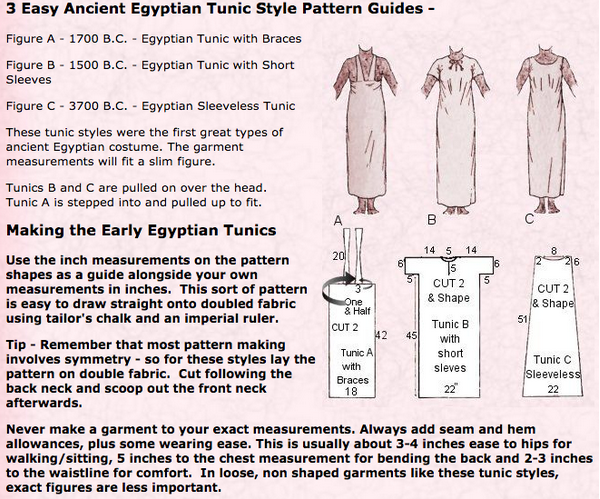Wikipedia says: “A tunic is a garment for the body, usually simple in style, reaching from the shoulders to a length somewhere between the hips and the knees. The name derives from the Latin tunica, the basic garment worn by both men and women in Ancient Rome, which in turn was based on earlier Greek garments that covered wearers’ waists.”
The tunic is a combination of two earlier technologies: 1. Needle and thread, evolved from the bone needle and sinew thread used to stitch animal hides, and 2. Woven material, made from plant or animal fiber, spun into thread, then woven into cloth. As seen in these earlier postings: https://folkdancefootnotes.org/clothing/a-brief-history-of-cloth/, and https://folkdancefootnotes.org/clothing/from-cloth-to-clothing/, cloth-making was a very laborious, expensive process, so early cloth was draped rather than cut to fit the body. It took a long time before someone was rich and/or brave enough to cut a hole in fabric so a head could be inserted, and a while longer yet before someone stitched up the sides to make what we now call a tunic.
No one knows when or by whom the tunic was ‘invented’, but likely suspects include Assyria and Egypt – early leaders in weaving technology. “Assyria was an important civilisation that emerged between 5000 B.C. and 2400 B.C. By the time of the dynasties of the Old Kingdom of Egypt in 2400 B.C., Assyria was also reaching its first golden age which would last for another 3000 years.”

By about 500 BC, Wikipedia lists several regions and cultures wearing local forms of tunic, such as: “the Indian Sub-Continent, including India, Pakistan and Bangladesh. The tunic is usually referred to as Kurta and is now an emerging women’s top style increasingly liked by many in the West.”
“Greek and Roman tunics were an evolution from the very similar chiton, chitoniskos, and exomis all of which can be considered versions of the garment. In ancient Greece, a person’s tunic was decorated at the hem-line to represent the city-state in which he lived. Tunics might be dyed with bright colours, like red, purple, or green.”


The Roman tunica was adopted by the Roman citizens in the 3rd century BC. It was often worn by citizens and non-citizens alike; citizens, though, might wear it under the toga, especially at formal occasions. The length of the garment, the presence or lack of stripes, as well as their width and ornamentation, would indicate the wearer’s status in Roman society. Roman senators, for example, used the Laticlavus, with broad purple stripes, and members of the equestrian class wore the Angusticlavia, with narrower stripes. Soldiers, slaves and manual workers generally had tunics to a little above the knee; those in more sedentary occupations to about the ankle (unless they were expecting to ride a horse, when a shorter one would be worn).[8]
Roman worker dressed in a tunic
The tunic or chiton was worn as a shirt or gown by both genders among the ancient Romans. The body garment was loose-fitting for males, usually beginning at the neck and ending above the knee. A woman’s garment could be either close fitting or loose, beginning at the neck and extending over a skirt or skirts.
After the fall of the Western Roman Empire, the long sleeved Celto-Germanic tunic continued to be worn. The construction was more elaborate than the earlier Graeco-Roman garment, with a tight-fitting neck with a split down the front for pulling it over the head, and gusset under the arms and inserted around the lower half to give a flaring skirt. Being used by both Vikings and Normans, the garment continued as a general male garment into the Middle Ages, still being used in Norway as late as the 17th century.
The various Celtic and Germanic peoples living in the colder Middle and Northern Europe wore long-sleeved tunics from as long back as pictorial evidence goes. Such tunics are often found depicted on the various Roman monuments depicting victories over these peoples, and show the tunic as a simple pull-over construction reaching to the mid-thighs or to the knees. Similar tunics were eventually taken up by the Romans, and continued to be used into the Byzantine period.
Tunics worn by the Celts were documented by the Greek historian Diodorus Siculus, (ca 70 B.C.) : “… the way they dress is astonishing: they wear brightly coloured and embroidered shirts, with trousers called braccae and cloaks fastened at the shoulder with a brooch, heavy in winter, light in summer.”
TODAY’S TUNICS
As more and more elaborate materials became available, the tunic evolved from being the only piece of clothing, to being the basis of other, fancier garments. Often, the tunic was the undergarment, worn to protect fancier garments from the effects of human sweat. As such it sometimes was the only garment washed. Most tunics today are considered underwear – the woman’s slip or chemise, the unisex t-shirt.
In Western culture, large external tunic use continues primarily in a religious and uniform context. It is the primary garment worn by the clergy and members of religious orders. The religious tunic reaches to the feet and was the source of the clerical cassock, as well as, in its liturgical form, the alb, after the long tunic worn by Roman citizens. ‘Tunic’ is also the name often given to the high-collar uniform coat worn by military and police personnel. Light feminine garments, especially for sports or exercise, usually only coming down to mid-thigh, are also called tunics.


Leave a comment